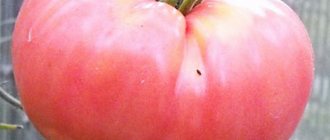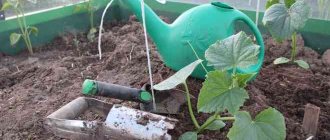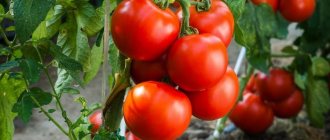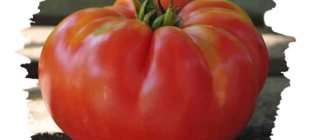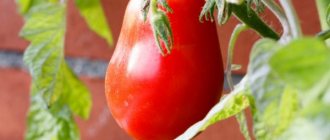Characteristics of Raspberry Elephant tomatoes
This is an indeterminate variety, the height of the bushes in open ground reaches 1.3 m, in a greenhouse or hotbed - 1.6 m. The leaves are dark green, with a shape characteristic of tomatoes. There are also potato varieties, depending on the seed supplier.
The culture is a hybrid with average fruit ripening periods. From the moment the seedlings are planted in the ground until the first tomato ripens, a little more than 100 days pass. The variety is intended for cultivation in greenhouses and open ground. Gardeners prefer to cultivate it under a film: tall plants often suffer from strong winds.
Raspberry elephant tomato rafts are large, fleshy, juicy. They have thin, smooth skin, which is not conducive to long-term storage or transportation. Up to 6 tomatoes weighing from 200 to 400 g are tied in one brush, in rare cases - up to 600-700 g.
The fruits have a round, slightly flattened shape, slightly ribbed near the stem. As you can judge from photos and reviews from farmers, the color of Raspberry Elephant tomatoes at the stage of full maturity is pale pink, raspberry, at the stage of ripening - orange.
Detailed description of the variety
Raspberry elephant tomatoes are classified as determinate varieties. This means that fruiting and plant growth are practically unlimited - the bushes continuously form young shoots, stretching to an average of 1.5 m in height, in open ground. In greenhouse conditions, the height of tomatoes can reach 2 m.
The shape of the leaves depends on the manufacturer. For example, agro seeds produce tomatoes, the leaf blade of which resembles a potato leaf in appearance. Tomatoes with ordinary leaves grow from planting material.
Advice! Due to the fact that the variety is determinate, bushes are formed into 1 stem, otherwise the tomatoes will become very small. To do this, it is necessary to regularly pluck the lateral shoots so that they do not draw useful substances from the bush to the detriment of fruiting.
One bunch produces from 5 to 7 tomatoes. Since the fruits are quite heavy, the shoots can bend under them and even break. To prevent this from happening, 1-2 ovaries are usually removed, thereby lightening the overall weight of the hand.
Description and taste of fruits
The name of the Raspberry Elephant tomato variety is based on the large size of the fruits of this variety. The weight of tomatoes varies on average from 300 to 600 g. Some reviews report that tomatoes can even grow in greenhouse conditions up to a record 800 g with proper care of the beds.
According to the description, Raspberry Elephant tomatoes are round in shape, but slightly flattened on top, as can be seen in the photo below. The color of ripened fruits is red-crimson, rich.
The skin of tomatoes is thin, barely noticeable. This feature allows tomatoes to safely tolerate low temperatures and ripen in low light conditions, however, such lightness becomes a disadvantage if the variety is grown for sale - the fruits do not tolerate transportation over long distances, they wrinkle, crack and do not retain their presentation for long. That is why they try to process the harvest as quickly as possible, using tomatoes to make pastes, sauces and juices.
Particularly noteworthy is the soft structure of the fruit pulp and harmonious taste - moderately sweet, sugary, without pronounced sourness. Each fruit contains from 6 to 8 chambers.
Pros and cons of the Raspberry Elephant tomato variety
Among the disadvantages of the variety, farmers point out its demands on soil composition, the need for regular and abundant watering, and vulnerability to sudden increases or decreases in air temperature. Tomatoes of this variety cannot be stored for a long time and transported over long distances.
The advantages of the Raspberry Elephant variety include:
- high taste qualities;
- friendly ripening of fruits;
- good presentation of tomatoes;
- large weight of each fruit;
- resistance to pests and diseases.
Important! The disadvantages of the variety can easily be turned into advantages if you grow the crop in a greenhouse.
Peculiarities
If you love huge tomatoes, then the description of the Raspberry Elephant tomato is for you, in a nutshell: a pink-raspberry tomato with sweet pulp. Believe me, it will decorate any table. Growing such a miracle in your dacha is simply a pleasure; tomatoes are very unique, they are worth doing just to try to get the biggest fruit, because tomatoes of this variety can even weigh up to a kilogram.
Multiple photos and videos allow you to get a more detailed look at the appearance of the Raspberry Elephant variety. Description of fruits:
- pink coloring;
- shape – round, flattened at the top;
- pulp – juicy, sweet in taste;
- peel - easily peeled off;
- has 6-8 cameras.
The size of the fruit ranges from 300 to 700 grams; if you try very hard, it is possible to grow a tomato for exhibition that will reach a weight of 900 grams. and higher. The skin of the pink beauty is thin and delicate, which gives its taste a special piquancy. The pulp is soft, sugary in texture, pleasant to the taste. Such tomatoes tolerate cold weather well and have the ability to ripen even without sunlight.
Advantages
Tomatoes of the Raspberry Elephant variety have virtually no flaws. Many gardeners speak highly of this variety. Among the main advantages, excellent taste is noted. The fruits are large, juicy, perfect for making any types of preserves.
Flaws
Fruits of this variety cannot be stored
The thin peel, on the one hand, is a great advantage, but on the other hand, it does not allow the vegetable to be stored for a long time. The qualitative characteristics of the fruits make them a favorite food for many pests.
Optimal growing conditions
The Raspberry Elephant tomato is a heat-loving plant. The creators of the variety recommend growing it in the southern regions of Russia. In the northern regions - use greenhouses and hotbeds. The soil should be well fertilized and moistened. Regular watering is the main secret to obtaining a high yield of the Raspberry Elephant hybrid. To get especially large fruits, the plant is left with one trunk, and the side shoots are pinched.
Important! The bush must be tied up; full-sized fruits at the ripe stage can easily damage the plant.
Sowing seeds
If you decide to grow Raspberry Elephant tomatoes, you will need to: germinate seedlings in advance, prepare a greenhouse or garden for planting bushes. The variety is mid-season, its ripening takes about 120 days from the moment of sowing the seedlings.
To begin with, let's prepare containers for sowing seeds - these can be just wooden boxes that we place in a warm, secluded place. We flavor the soil with humus and put it in boxes. Then we place the seeds at a depth of 2 cm and make as many rows as your container allows. The distance between rows is 1.5-2 cm. Seeds must strictly be kept underground.
Next, water the planted seeds with water, but the main thing is not to overdo it and do not flood them. We cover the top with film, referring to numerous reviews, such actions will create condensation, thereby accelerating the growth of seedlings. Now we just have to wait for the small plants to hatch. Reviews from experienced farmers say that the Raspberry Elephant tomato shoots appear within a week or a week and a half after sowing.
As soon as you see that the sprouts produce 2-3 leaves, you can start picking the plants. Picking should be done at an early stage, while the sprouts have not yet developed a large rhizome. Care during the growth of bushes in pots consists of:
- moderate watering from a sprinkler, every day;
- fertilizer, 2 times per month, with liquid fertilizers.
So, let’s summarize the stages of seed growth:
- landing in the ground;
- the appearance of sprouts;
- transplanting into pots.
Agricultural technology of tomato variety Raspberry elephant
It is easy to grow a hybrid from seeds at home. The main thing is to purchase high-quality seed material.
Growing seedlings
Before sowing, the seeds are washed in warm water and soaked for half an hour in a slightly pink solution of potassium permanganate. In this case, the grains that float to the surface can be discarded; they are empty.
Containers for seedlings are filled with a special mixture for growing tomatoes. You can make it yourself if you mix garden soil with humus and sand in equal parts. The resulting soil mixture must be thoroughly ground so that the soil is not heavy and all its components are well distributed. Then the ground is watered with settled water at room temperature.
Important! There should be drainage holes in the bottom of the seedling container. Stagnation of moisture leads to rotting of the seed.
Raspberry elephant tomato seeds are sown in early March. Using a ruler or knife, make even furrows no more than 1 cm deep on the surface of the soil. Seeds are placed in them at a distance of 2 cm. The seeds are covered with a small layer of fluffy soil and covered with film. The containers are placed in a bright, warm place.
After 3 days, the film is removed, after 6 days the first shoots will appear. They need 12 hours of even light. To do this, special lamps are additionally turned on in the evening hours.
After 2 months from the moment of sowing, from 4 to 6 leaves appear on the sprouts. At this moment, the seedlings are planted (planted in separate containers). Choose only strong plants with thick stems and fleshy leaves.
Peat cups are used for replanting. They are filled one third with soil for planting. Then the seedlings are well moistened, dug up, being careful not to damage the root, and transplanted to a new place. At this time, the seedlings can be topped up with fertilizers for tomato seedlings. The backlight is left on for 12 hours a day.
A month before the intended planting of seedlings in the ground, it must be hardened off. To do this, containers with seedlings are taken out into the open air for 2-3 hours a day.
Important! Pots with plants should not be left in direct sunlight; Raspberry Elephant tomatoes should be shaded.
Landing rules
The seedlings are transferred to open ground in May. Night frosts on the soil should stop by this time. In the greenhouse, seedlings are rooted earlier. The soil for planting is prepared in the fall. It is carefully dug up and any organic fertilizers are added.
When planting Raspberry Elephant tomatoes, maintain a distance between plants of 40 cm and rows of 60 cm. There should be no more than 4 bushes per 1 m2. The holes are dug at least 30 cm deep and slightly larger in diameter than the rhizomes of the plants.
The seedlings are thoroughly watered and removed from the container; if peat cups were used, the plants are planted with them. The bushes are lowered into the prepared hole, sprinkled with soil, and watered. The bottom pair of leaves should be removed. After watering, the soil can be mulched.
Watering and fertilizing
Raspberry elephant tomatoes require frequent and regular watering. They are carried out twice a week in the spring, and every other day in the hot summer. Take settled water at room temperature. It is not recommended to water tomatoes with cold liquid. For one adult plant, take from 5 to 10 liters of water; for seedlings, 2 liters is enough.
Raspberry elephant tomatoes are fed 2 times a month with organic fertilizers. Cow dung or bird droppings will do. This substance is diluted with water in a ratio of 1:10, poured between the rows, slightly retreating from the root.
Important! Fertilizers should not be allowed to get on the leaves and stems of tomatoes.
Pinching and tying
The Raspberry Elephant tomato, due to its length and full-sized fruits, needs strong, reliable support. The plant is attached to a stretched trellis with a rope almost immediately after rooting.
To reduce the density of side shoots (stepchildren), they must be removed regularly. The abundance of such shoots reduces the yield of tomatoes. As soon as the flower cluster begins to form, thin branches form at its base and in the axils of the leaves. They are removed before flowering begins. For indeterminate varieties such as Raspberry Elephant, such a procedure is necessary. It is carried out at least once a week. Stepchildren are separated from the bush while they are still thin and weak. Tearing off overgrown shoots can damage the entire bush.
Formation
You can grow tomatoes with 1 or 2 stems. If they want to get a single stem, the side shoots are removed. In this case, there will be few fruits, but they will all grow to 400 g or more.
To form the second stem, it is necessary to leave a side shoot, which is located under the first lower brush. The remaining lateral processes should be removed. Growing into 2 stems, the tomato will form a larger number of ovaries, but the weight of the fruit will not exceed 200 g.
Protection from diseases and pests
The Raspberry Elephant tomato variety is susceptible to fruit rot. To prevent its occurrence, the frequency of watering must be reduced, the leaves and stems must be treated with a solution of nitrate.
Tomatoes are also susceptible to attacks by the Colorado potato beetle and aphids. Chemicals are used to kill these pests.
Planting and watering
Plants are planted no more than 4 per square meter with a distance of 60 x 40 cm. Sprouts carefully removed from the pots are placed in dug holes 25 cm deep, the lower leaves are removed, sprinkled with earth, watered, topped up with soil, lightly compacted and watered again.
Water the plants regularly and abundantly every 5-7 days.
Fertilizing is done once every 10-15 days with organic matter at the rate of 2-3 liters of solution per bush. As a top dressing, a solution of 1 bucket of manure per 100 liters of water is used.
It is recommended to mulch the soil with a layer of 5-6 cm of rotted sawdust, humus or peat. The use of mulch protects the soil from drying out, overheating and provokes rapid reproduction of worms beneficial to tomatoes.
Landing
Sowing of seedlings is carried out in the second half of March, two months before transplanting to a permanent place. Most often grown in greenhouses.
The seed material is pre-disinfected in potassium permanganate for 15-20 minutes (purchased ones usually do not need this). The seeds are deepened into watered and fertilized soil by 1-2 cm. The tray is tightly covered with film and placed in a warm place (at a temperature of 21-24 ° C).
Tatyana Orlova (Vasilidchenko) (candidate of agricultural sciences):
If tomato seeds were purchased in a store and are inlaid (the seeds are painted in different colors), this indicates that they are already pickled and do not need disinfection. You should also not soak such seeds before sowing. It is advisable to disinfect seeds without encrustation by any of the possible methods.
Shoots appear in about a week. Remove the film from the tray and carefully water the sprouts. For 5-6 days, the temperature is lowered to 18°-20C during the daytime and the tray is placed on the windowsill (or under a lamp).
When the seedlings have a pair of true leaves, they can be picked.
Two weeks before planting, the plants begin to harden: they are taken outside for a couple of hours every day, and the time is gradually increased.
Transplanting seedlings
The seedlings must be watered with warm water
Before transplanting plants into the greenhouse, the soil is loosened and fertilized, and a trellis or individual supports for the bushes are prepared.
2 bushes are planted per m² when formed into 2-3 stems, or 3 bushes - when formed into 1 stem.
The plant is placed in a hole together with a peat pot or a lump of earth, watered under the root with warm water, compacted and watered again.
Country of origin and where is the best place to grow?
“Crimson Elephant” was obtained in Russia by L. Myazina, who is the author of many hybrids; this tomato was the result of her many years of work. It received registration as a variety in 2009 . After this, he earned respect and popularity among gardeners for his qualities.
If you grow this type of tomato in open beds, then only warm southern regions are suitable for this, since the plant is heat-loving and demanding of light. The Astrakhan region, Belgorod, Rostov-on-Don, Crimea, North Caucasus and Krasnodar region are most suitable. In the central and more northern regions, this tomato will give an optimal harvest only in a special spacious greenhouse.
Diseases and pests
Late blight
Fighting methods:
- in the spring, carry out sanitary treatment of the greenhouse: remove all dirt and plant debris from the walls and roof;
- 7-10 days after planting the seedlings in a permanent place, sprinkle the soil between the rows with ash (before watering), repeat when the ovaries begin to appear;
- Spray the bushes every 14 days with milk and iodine: dissolve 1 liter of milk in 10 liters of water, add 15 drops of iodine
Tobacco mosaic virus
Control methods:
- disinfect seeds before sowing (the main source of disease development is contaminated seed);
- cannot be treated: diseased plants are dug up along with the soil and destroyed;
- the hole from the bush is spilled with a solution of potassium permanganate and filled with new soil;
- the remaining plants are sprayed with whey solution every day for 14 days, then once a week
Scoop
Control methods:
- treatment of plantings with Citkor, the solution is prepared according to the instructions, it is valid for 3-4 weeks;
- spraying plantings with Inta-Vir every 2 weeks
How to care
Tomatoes need constant care. If you do not provide them with the necessary conditions for growth, the fruits will not ripen to the required size, and the taste will not be as sweet as it should be. Care is not that difficult.
The greenhouse must be ventilated daily by opening the window and door. This way the plants will receive the necessary air, and excess moisture will leave. Water these tomatoes twice a week. There should be enough water, but it is not recommended to fill them, otherwise rotting will begin. Watering is carried out at the root. The leaves can be lightly sprayed with clean water; the water should not be icy, preferably settled. It can be poured into a barrel in advance.
You need to be very careful to ensure that the soil is good, fertilized, and not acidic. You can purchase a special device for measuring acidity. Top dressing can be at the root or foliar. As fertilizers, these varieties prefer manure, humus, chicken droppings, ammonium nitrate, potassium sulfate, nitrogen, and minerals. The best time to feed is early morning or evening.
All weeds must be removed by the roots, otherwise the fruits may grow tasteless and small, because the weed takes away all the juices from the crops. In addition, it can transmit pests. At the same time, loosen the soil twice a month so that it is soft and light.
Pest control and preventive measures are the most important part of caring for hybrids. You can spray the foliage with soap solution, potassium permanganate, infused herbs or garlic solution. Among the harmful insects, beetles, mites, butterflies, slugs, and caterpillars most often attack.
If tomatoes become stained or develop fungal infections, it is best to remove spoiled leaves and fruits and purchase remedies for these diseases at the store. But the elephant rarely gets sick; it has a strong immune system. He can begin to suffer only if he is not properly cared for. Therefore, it is necessary to carefully monitor the quality of watering, the level of humidity and feed on time.
Recommendations for growing varieties
These tomato varieties are suitable for growing in any region of the country. Preparing the soil for planting “Raspberry Miracle” tomato seeds must be done in the fall. You can prepare the soil mixture yourself. To do this, you need to mix sand, garden soil and humus in equal parts.
Seeds should be sown between March 1 and March 10. Fill containers for planting with soil mixture, which can be used as ordinary plastic bottles with a cut off neck. Before planting, it is recommended to water the soil with a weak solution of potassium permanganate. Seeds should be treated with a 1% solution of “Baikal EM-1” or “Ecosila”. After this, about twenty seeds must be poured into each container with soil.
After the first shoots appear, remove weak and crooked shoots. After this, every week you need to remove those sprouts that are lagging in growth. This should leave you with between seven and ten plants in each container. This growing method does not involve picking tomatoes. But if it is necessary, then for this you will need pots measuring ten by ten centimeters.
After planting in the ground, mandatory measures for caring for tomatoes should include regular watering, weeding and loosening the soil, as well as the application of complex mineral fertilizing. Since the bushes are tall, they need staking.



